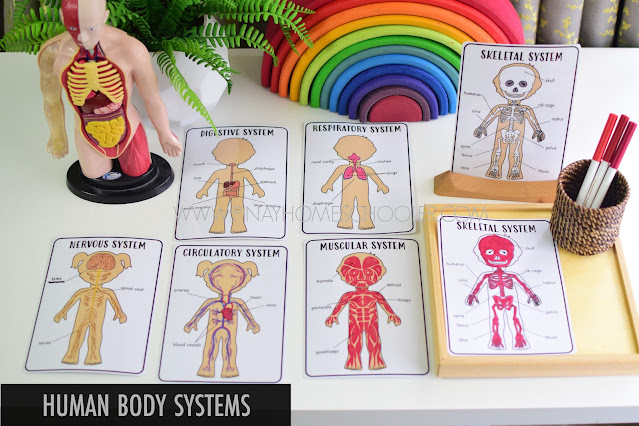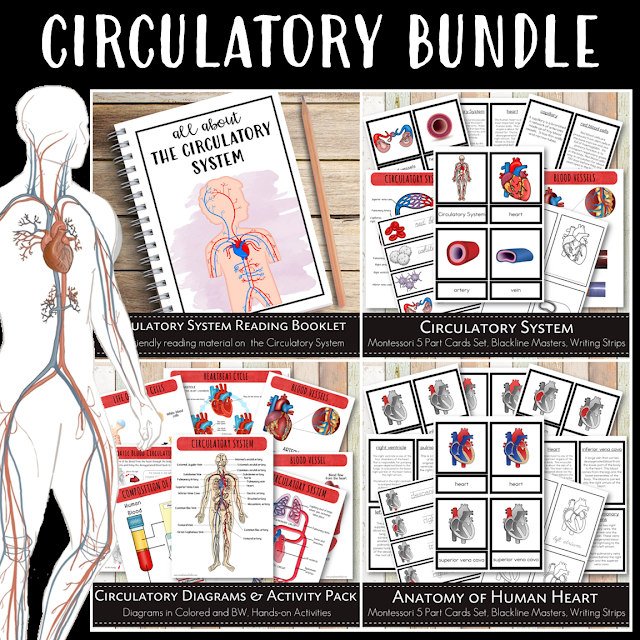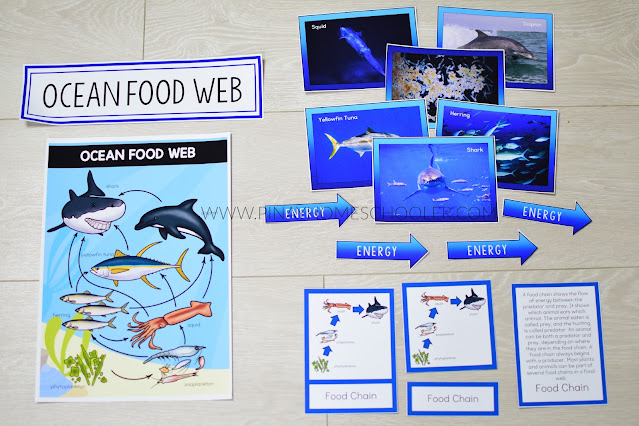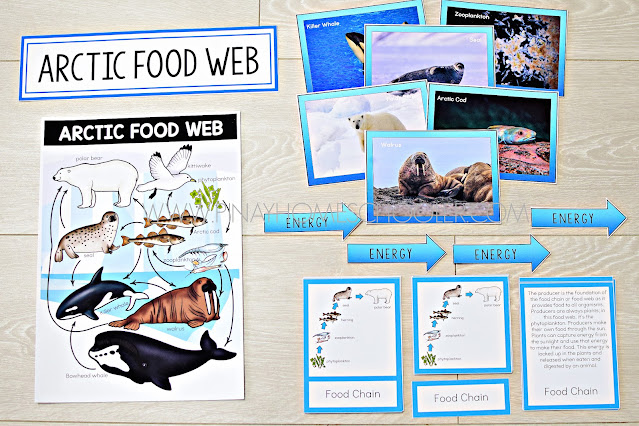This learning pack was a great help when introducing the human body systems to my now fourth-grade boy. I'm sharing some of the highlights of our activities and previews of the contents of this learning pack that is perfect for early learners and upper elementary students.
Mountain Biome Food Web and Food Chains Learning Resources
Tuesday, June 13, 2023
Presenting our Mountain Food Web and Food Chains Learning resource. This packet is part of our Food Web Biome Bundle Pack. The bundle contains 10 sets of food web activities in the 10 biomes worldwide: Arctic, boreal forest, deciduous forest, desert, mountain, ocean, pond, rainforest, savanna, and tundra. This post gives you a glimpse of our Mountain Foodweb packet.
Circulatory System Learning Resources for Kids
Monday, April 3, 2023
Ocean Biome Food Web and Food Chains Learning Resources
Saturday, February 26, 2022
Presenting our Ocean Food Web and Food Chains Learning resource. This packet is part of our Food Web Biome Bundle Pack. The bundle contains 10 sets of food web activities in the 10 biomes worldwide: Arctic, boreal forest, deciduous forest, desert, mountain, ocean, pond, rainforest, savanna, and tundra. This post gives you a glimpse of our Ocean Food Web packet.
Arctic Food Web and Food Chains
Tuesday, January 11, 2022
I'd like to introduce a new product in our shop, the Food Web Biome Bundle Pack, which my son and I recently used to discuss life in the Arctic. Our Food Web Biome Bundle Pack contains 10 sets of food web activities of animals in the 10 biomes worldwide: Arctic, boreal forest, deciduous forest, desert, mountain, ocean, pond, rainforest, savanna, and tundra. This post features our Arctic Food Web and a sneak peek at some of the biome sets.
Animal Characteristics (Vertebrates) Learning Pack
Friday, April 5, 2019

With this learning material, your students will be able to learn the characteristics of amphibians, mammals, reptiles, fish, and birds through visual representation and hands-on activities. There are 8 characteristics provided for each animal for you to explore.
Learning The Human Skeleton for Preschoolers
Wednesday, October 18, 2017

Montessori Inspired Parts of a Flower Activities
Thursday, February 23, 2017
For Mavi's midterm break, I am planning activities that both my 3-year-old and 8-year-old boys can participate in. One of the activities is to learn about flowers and their composition. Despite having done this activity before at the ages of 4 and 6, Mavi is still excited to do it again with his younger brother. This is a new challenge for me as I need to ensure that the activity is engaging for my younger son, while also conveying information to my older son. In the post, you can find out how I made the boys work together in the activities that I prepared for them.
Teaching Kids About their Lungs
Saturday, May 21, 2016
Teeth Activity for Toddlers! (29 Months Old)
Thursday, May 5, 2016
Homemade Face Puzzle for Toddlers
Wednesday, May 4, 2016
Vito is 29 months old.
So I was brainstorming the other way of what else could we do for our Body Unit and Mavi suggested that I should give Vito do a puzzle work. But he worked with our favourite body puzzle already and Mavi said, what about creating Vito’s face? And it hit me! Why not print a picture of Vito and turn it into a puzzle! This way he’ll be familiar of the order of his face from top to bottom, right?
Internal Organs Sensorial Tub and Matching Activity
Tuesday, May 3, 2016
Vito is 29 months old.
This is one of the highlights of our Body Unit! I was more than excited to give this to Vito! Just look at his face on how much he’s enjoying this activity!
Beleduc Boy Body Puzzle
Saturday, April 30, 2016
One of my best finds this year is this absolutely amazing learning material from Beleduc. Just like Grimm and Shleich, Beleduc is a German company that produces high quality wooden learning materials that are designed for kids of all ages. I absolutely love this puzzle because for Vito, he is just playing a game but little did he know that he is actually learning!
Learning about Faces!
Tuesday, February 23, 2016
The boys (and I) had so much fun making faces! This is a simple activity that you can do with your kids with minimal preparation. It’s the perfect opportunity to learn about emotions and the facial expressions they can make!
Learning the Parts of the Human Eye
Saturday, February 20, 2016

It’s Mavi’s midterm break and we decided to look into the parts of the human eye! We examined our model unit this morning which we bought last year from the local store. It’s so perfect and goes along so well with our Human Eye Nomenclature Cards and Booklet.
The Study of the Circulatory System for Kids
Friday, October 16, 2015

It’s another 12 Months of Montessori Series and today I’m going to share with you some simple and easy to prepare lessons and activities for learning the circulatory system of the human body. I mentioned earlier how Mavi was asking me a lot of things about the human heart and the diseases of the heart that causes death in some famous people. Bombarding me with so many questions and that eagerness to learn, we worked on this unit study to:
- Learn about the human heart and how it functions
- What causes heart diseases
- A better understanding of blood vessels: vein and artery
- How to prevent heart diseases
- What’s the role of the blood in the human body
In this unit study, we focused on the three major elements that comprises the circulatory system:
- the human heart
- blood vessels
- human blood
As a bonus, I also added a few pointers on how to have a healthy heart!
The Human Heart
Last month, we learned about the human heart, the different parts and how it functions. You can learn more about it in this post, How to Teach the Anatomy of the Human Heart to Kids.

Blood Vessels
First we plotted the network of blood vessels in our body using our Cardiovascular Information Diagrams sheet as a guide and a printed outline of the human body. We used PlayDoh (red and blue) to represent the vein and artery.
This activity will introduce the child to the basic concept of how blood is distributed in our body. By plotting the veins and arteries, they will understand how the organs in the body receives oxygen and nutrients.

Working diligently to replicate our guide

And he realized that even the head have blood vessels!

We went a little farther by inspecting the network of blood vessels, learning the difference between the veins and arteries and capillaries. Below is a demonstration of the direction of the blood flow in the body through the blood vessels, of how oxygen rich blood enters the artery (except pulmonary arteries) to the capillaries (where oxygen is distributed to the organs) and passes through the vein to enter the human heart.

Here Mavi’s creating an artery, vein and capillary.


He even made his network and labelled the parts.

The Human Blood
This is to demonstrate the composition of blood. 45% red blood cells (red coloured water), 54% plasma (cooking oil) and 1% platelets (bubbles in between).

Care of our Heart
These cards are included in our heart model. It identifies 10 foods that are essential for a healthy heart. Mavi was seriously reading all through the 10 cards and checking if he’s consuming them. Well of course, he eats almost everything in the list except for the broccoli and wine

And that ends our circulatory system unit. For more biology related posts see the following:
For more details on the Circulatory System learning materials you can check this post, Circulatory System Learning Materials.
Don’t forget to PIN this for later! I assure you that you will be needing this in the future


Collection of Human Body Activities for Kids and {Learn & Play Link Up}
Wednesday, September 30, 2015
Kids love to learn their body parts! Our human body activities has always been a favourite at home and with my readers as well. Here are some of our favourites throughout the years:

GUIDELINES FOR LINKING
<div align="center"><a href="http://christianmontessorinetwork.com/category/learn-and-play" title="Christian Montessori Network"><img src="http://www.christianmontessorinetwork.com/wp-content/uploads/2015/04/learn-and-play-link-up-150-150.png" alt="Christian Montessori Network" style="border:none;" /></a></div>How to Teach the Anatomy of the Human Heart to Kids
Sunday, September 27, 2015
Objectives on why we study the human heart:
So let me share with you how we worked on our human heart. Links to the materials used are provided at the end of this post, including where to buy heart models.
The Human Heart and its Parts
Of course, having a heart model adds up to the fun in learning. It’s the closest we can get to visualize what the heart really looks like, unless we dissect a pig’s heart
How the Human Heart Works
Heart Diseases
And that’s about it, our human heart study. I hope you find this post helpful!
Materials Used:
- Cardiovascular System Bundle Pack, this is the bundle that includes Cardiovascular System Information Diagrams, The Human Heart learning pack, and The Cardiovascular System
- Cardiovascular System Information Diagrams
- The Human Heart
- The Cardiovascular System
Where to buy Heart Model (US):
Where to buy Heart Model (UK/Europe):
- Eason’s (if not available online, visit the store)
- Hamley’s (if not available online, visit the store)
- 4D Human Heart Anatomy
- Learning Resources Human Heart
Letter E: Parts of the Body Unit Activities
Sunday, September 20, 2015
Last week, I put up a body parts unit study for Vito with emphasis on the letter E. I’d like to share some of the materials and activities I prepared for him, of which he truly enjoyed.
1. Recognition of body parts.
Vito knows most of his body parts so I introduced our Body Parts Cards to him for abstract presentation. The cards were used for identification, but in different ways.
- I would show the card and ask “what’s this?” Vito would answer and at the same time point to that part of his body.
- I used the doll for identification (3rd person) like “where is the dolly’s hair?”
- I could see him at times looking at the cards and imitate the picture. So cute!
We are using my The Parts of the Body cards which you can get from here.
I’ve got three objects for our letter e: eye, elephant and egg. I so love this method! To expand the child’s vocabulary, learn phonics and letters all at the same time!
Vito always goes to this tray and would give me the object and say its name. As for letter e, I love that he can remember the sound of ‘e’ whenever he encounters this in books! How amazing!
3. Writing using our Egg shaped crayons
We are using Crayola here.
4. Tracing the body

5. Letter E for egg
So he worked on peeling the eggshells…
and devoured the egg!
And we later on used the eggshell in our letter E craft.
I cut out some different shapes, used a yarn for the hair and paper plate for the head and we have this cute face! Vito was happy enough to wipe out all the glue as well.
7. Body Parts Puzzle
Yes, if there’s one time that a little toddler can do with body parts is to start using a simple dress-up bear puzzle, with head, body and legs portion and being emphasized. He couldn’t fit perfectly the pieces yet but he knows exactly where to put the head, limb and legs. We’ll do more of this!
And that’s about our activities for learning the body parts. Don’t forget to pin this for later!
And please follow or visit Pinay Homeschooler on Pinterest
Follow Pinay Homeschooler's board Pinay Homeschooler on Pinterest.








































